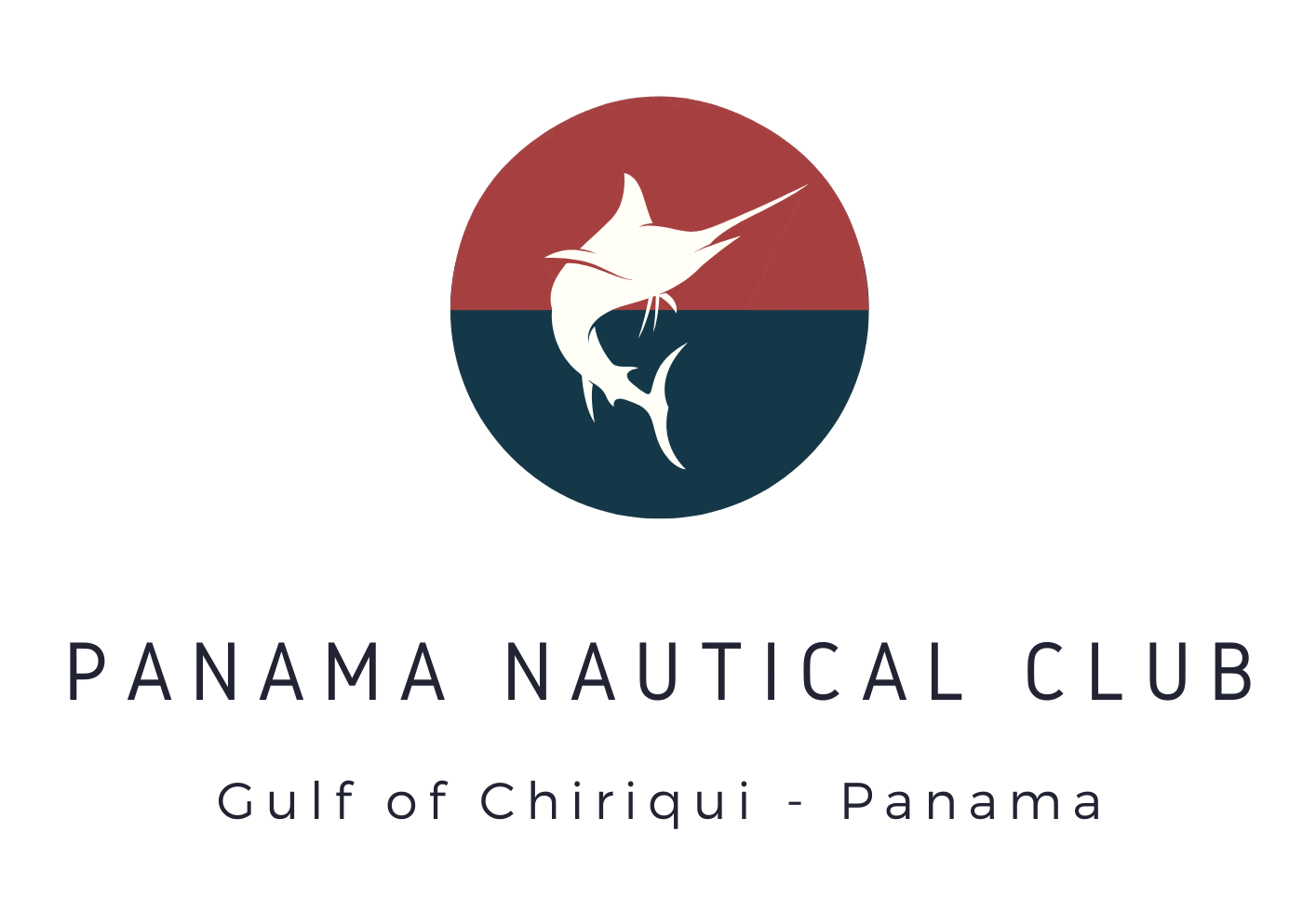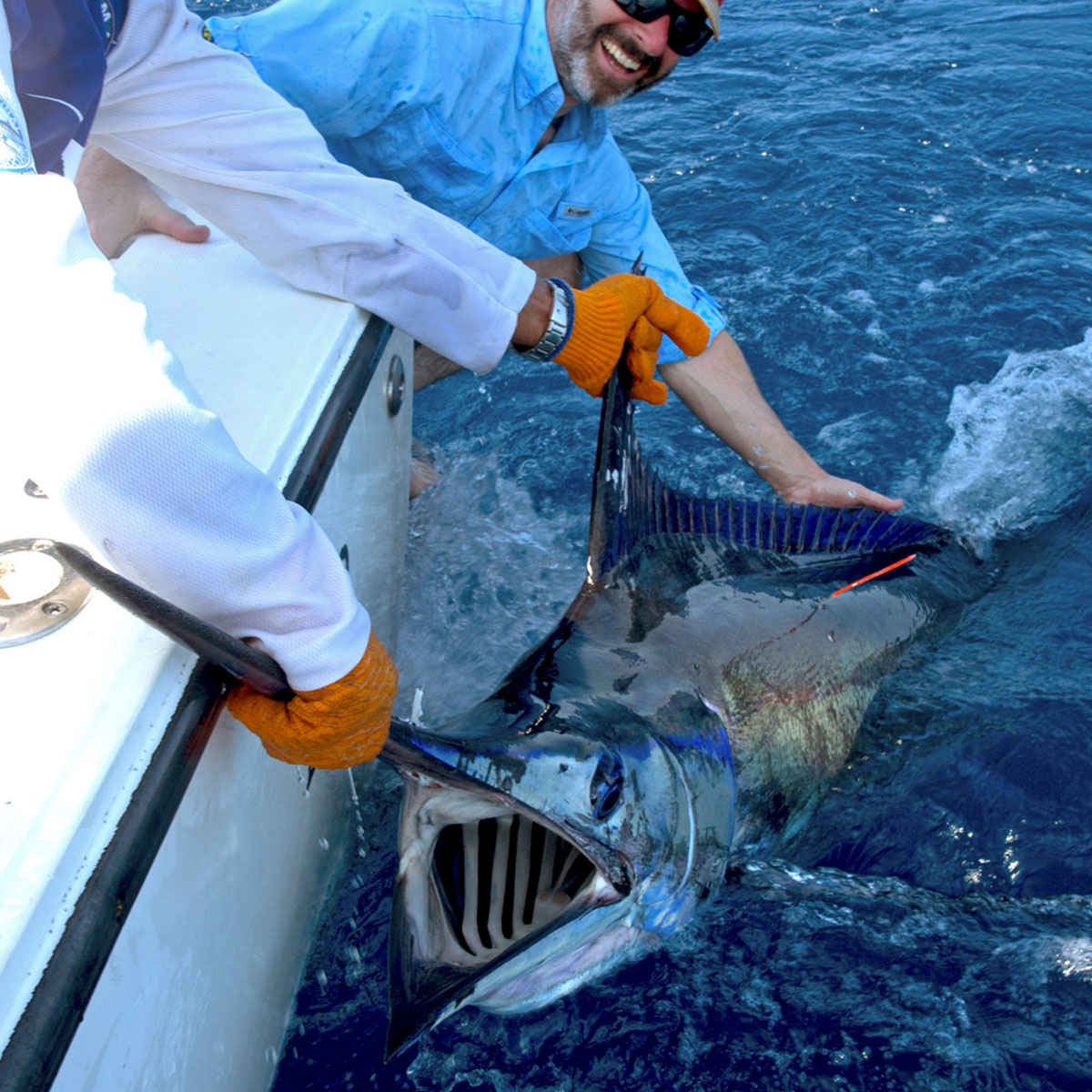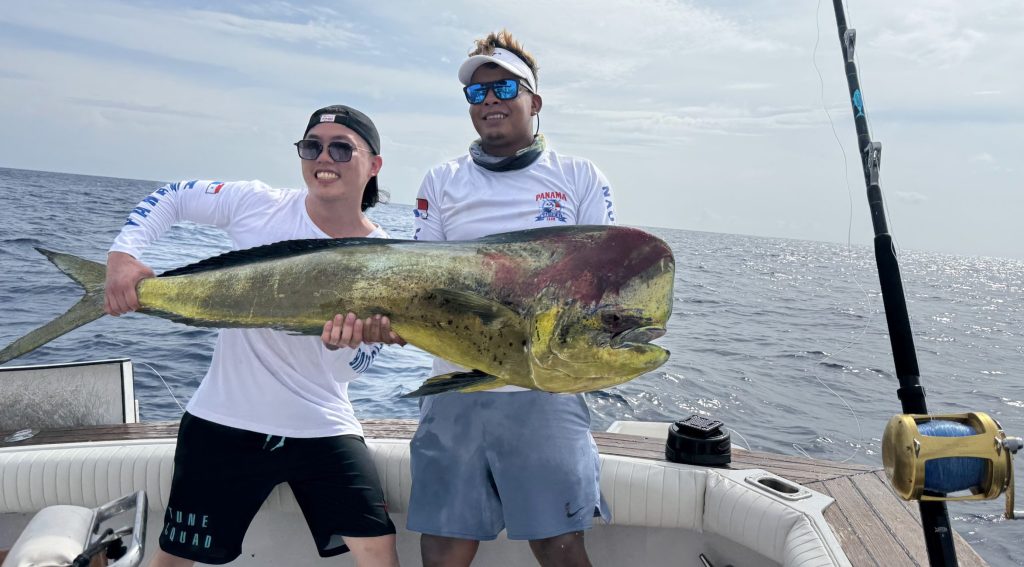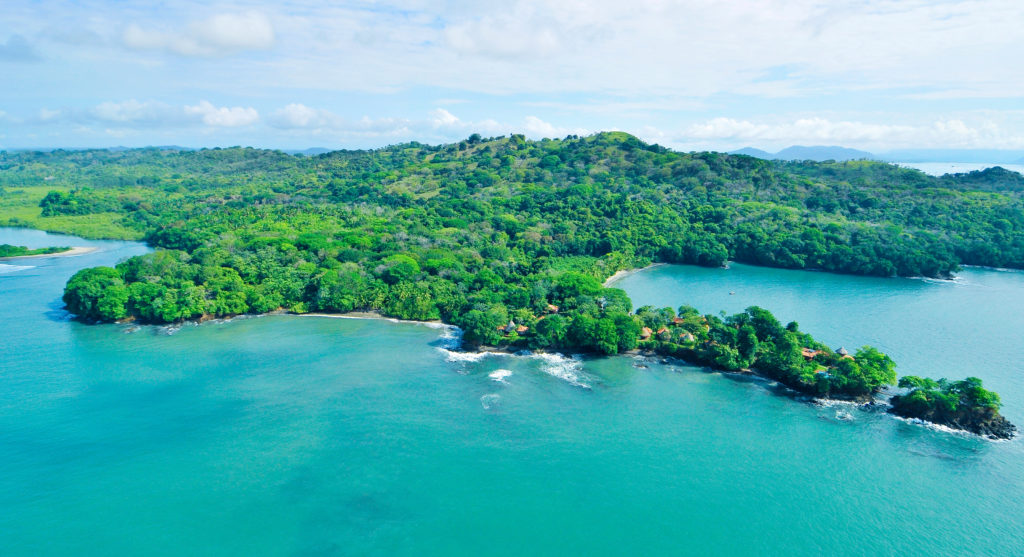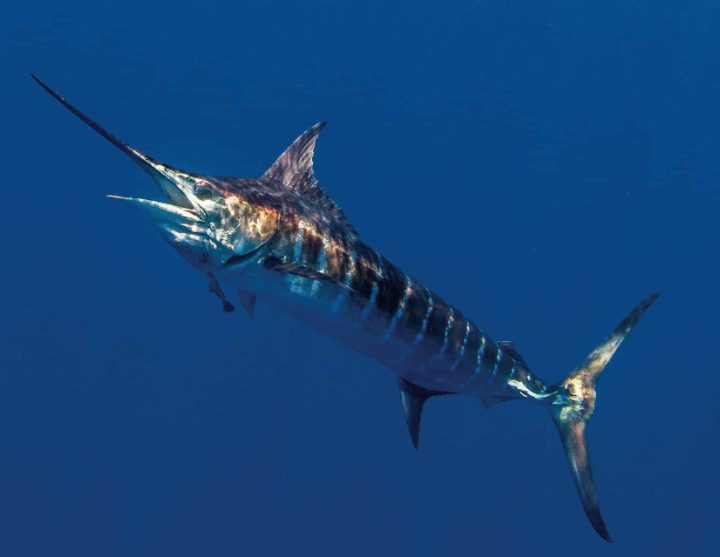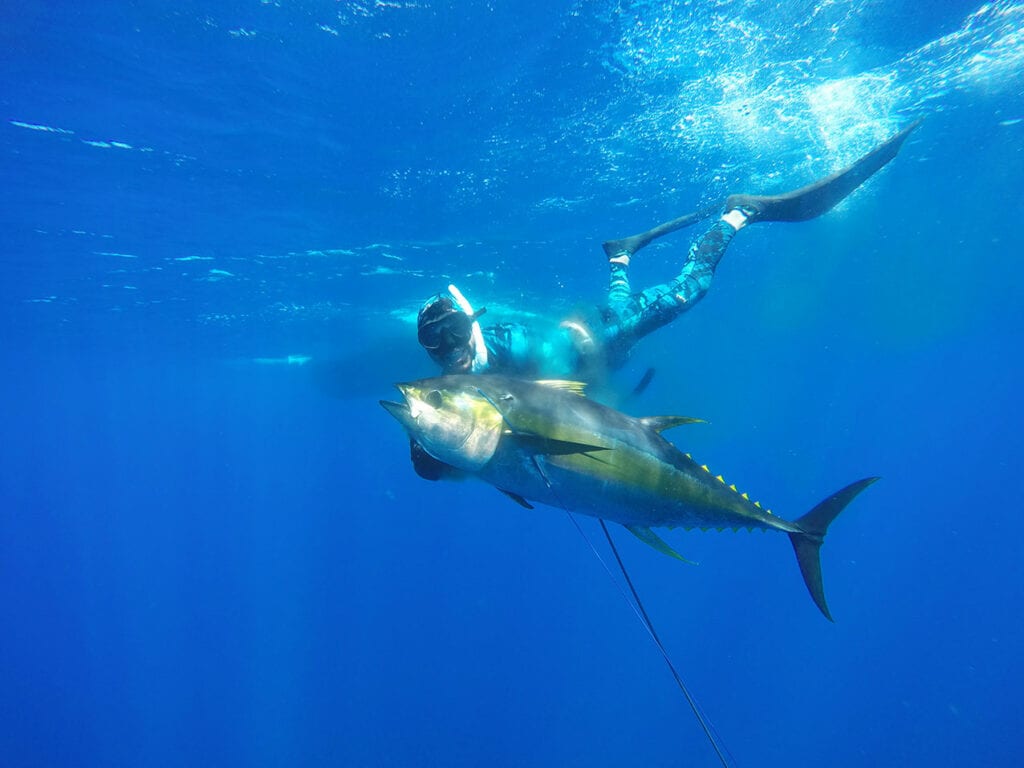Panama’s Gulf of Chiriquí is famous worldwide for its sportfishing, especially since the first world-record Black Marlin was caught here in 1949. The beast weighed in a 1006 pounds! This catch put Panama on the map as a top fishing destination, drawing fishermen from everywhere. The Gulf’s special underwater landscape and strong currents make it a rich place full of marine life. The gulf’s underwater terrain and strong currents make this a unique ecosystem. The waters are full of nutritious food for the baitfish, who in turn attract trophy fish such as marlins, tuna, and roosterfish.
In this guide, we’ll explore the thrilling sport of marlin fishing in Panama. We’ll also look closely at the two types of marlin you can catch in Panama: black and blue marlin, two types of marlin that are among the favorites for sportfishermen to catch. For sport fisherman, Marlin Fishing in Panama has become a tradition for many with the Gulf of Chiriqui being one of the most popular spots for repeating guests.
The Best Time for Marlin Fishing in Panama
It is possible to catch a marlin any month of the year. However, to increase your success of catching a prized marlin we suggest visiting between December and February. They are usually found around Hannibal Bank and Isla Montuosa.
Types of Marlin Found in Panama
Marlin are part of the billfish family. They received their name due to their long, spear-like bill which they use to attack their prey. There are many types of marlin, but two types you will come across when marlin fishing in Panama: Blue Marlin and Black Marlin. These species are some of the most sought-after gamefish by avid fishermen across the world. Both black and blue marlins are known to be aggressive apex predators and can grow over 1,000 pounds. Each one has unique characteristics that many fishermen study to ensure they’re able to land the catch.
-
Blue Marlin
The Blue Marlin is known to dive deeper and get tired faster than other species. However, it is still an aggressive and powerful fish known to put on a show, jumping high in the air when caught.
-
Characteristics
Blue marlins are the marathon runners of the sea. They are one of the fastest, largest and most recognizable fish in the world, with their silver and cobalt blue bodies that make them stand out. They’re known for their incredible ability to dive deep and fast into the ocean, making them a challenging catch. They tend to tire out quicker than black marlins, but don’t let that fool you; they put up a fierce fight. When hooked, blue marlins are famous for their breathtaking jumps out of the water, thrilling anglers with their power and beauty. On average, male blue marlins are smaller, with most marlins caught between 200 and 400 pounds. However, the females are the real giants of their species, often weighing four times more, especially those found in the Pacific Ocean, which are believed to be larger than their Atlantic counterparts.
-
Habitat
They can be found in the warm and tropical waters of the Atlantic from Canada to Brazil, Pacific, and Indian Oceans. They favor the vast, open waters of the deep ocean. They are pelagic, meaning they live in the part of the ocean away from the shore and the bottom, preferring to roam in the blue depths where they can find plenty of baitfish to feed on. For anglers, this means preparing for a journey into the deeper parts of the sea. Finding blue marlins requires patience and willingness to travel significant distances offshore, where the water’s blue vastness is their playground.
-
Mating
Blue marlin breed in late summer and fall. Females may spawn as many as four times in one season and often release over seven million eggs at once. They are often been reported to spawn near Cuba between May and November, hatching within a week after spawning. The mother lays her eggs in the open water and they float along until hatching with no parental care.
-
What do they eat
Mahi mahi, skipjack, mackerel, bonito, tuna, squid.
-
Fishing Techniques
To lure a blue marlin, your technique needs to account for their deep-water hunting grounds. Using artificial lures or rigged baits that mimic the appearance and movement of the marlin’s favorite prey can be incredibly effective. Most commonly, anglers use artificial lures to catch blue marlin. Trolling rods, large conventional reels and strong monofilament line is recommended when fishing blue marlin. Since blue marlins are known for their dramatic leaps out of the water, techniques that provoke these jumps not only increase your chances of a catch but also promise a visually stunning experience. It’s a test of both the angler’s skill and the equipment’s capability to handle such powerful displays.
-
Black Marlin
Black marlins earn their nickname, “Bull of the Sea,” through their sheer strength and endurance. As such, it can take fishermen hours to pull one in. Different from the Blue Marlin, they prefer more shallow waters near islands and reefs; however, you may occasionally find one in open waters.
-
Characteristics
Black marlin is the only marlin species with non-retractable fins. Feauturing a dark blue dorsal (along their backs) with vertical stripes running down their sides, and feature a silver belly and are usually larger around the head area vs blue marlin. They also tend to have the lowest dorsal fin size to body height proportion vs other species, at less than half of their body height. Black marlins can grow up to 15 feet in length and can typically weigh anywhere between 400 to 1000 pounds. Similar to their blue counterpart, the males are smaller than the females, with males rarely weighing more than 400 pounds.
-
Habitat
Black marlins can be found in tropical and subtropical areas of the Indian and Pacific Oceans, and ocassionaly in the Atlantic. In contrast to blue marlins, black marlins are more inclined to stay in the shallower waters near islands and reefs. These areas offer abundant food sources and the warm, sunlit waters that black marlins enjoy. Fishing for black marlins often involves less travel from the coast, but it demands a detailed understanding of the local marine landscape. Knowing the specific areas where reefs and islands create the ideal habitat for black marlins is key. These spots, rich in marine life and closer to the surface, provide thrilling opportunities to encounter the formidable “Bull of the Sea.”
-
Mating
They prefer water temperatures around 27° to 28°C during spawning and females can produce around 40 million eggs. The mother lays her eggs in the open water and they float along until hatching with no parental care. Once hatched, the fish spends most of its life alone.
-
What do they eat
Mahi mahi, mackerel, squid, cuttlefish, octopuses, trevallies, small tuna.
-
Fishing Techniques
Their affinity for shallower waters near islands and reefs, presents a different challenge. Live bait is king when fishing for black marlin; it’s more enticing due to the natural environment these marlins are accustomed to. Positioning your bait strategically in these areas can lead to more successful catches. Anglers should brace themselves for a lengthy battle when hooking a black marlin. Their bulkier build and higher endurance make them a more challenging catch, and don’t tire out as easily as blue marlin. The gear used must be robust, capable of withstanding the immense force and endurance these marlins exhibit during the fight.
Marlins Impact to the Ecosystem
As apex predators, blue and black marlins help maintain the balance of marine life, controlling the population of smaller fish and ensuring a healthy ecosystem. This natural regulation is essential for the ocean’s overall wellbeing. Catch and release practices allow these marlins to fulfill their ecological roles, ensuring future generations can enjoy the thrill of the catch while also preserving the ocean’s rich diversity.
Catch and Release
While the allure of catching such impressive fish is strong, it’s essential to remember that blue and black marlins are appreciated more for their ecological role vs the taste. The excitement of marlin fishing in Panama is unparalleled, but it’s vital to approach this sport with a conservation mindset. Blue and black marlins are considered protected species, due to their declining populations caused by overfishing and habitat destruction and are not just trophies but crucial parts of the oceanic ecosystem. Furthermore, their meat, particularly in larger specimens, can contain high levels of mercury, posing health risks. Practicing catch and release ensures that these magnificent creatures continue to thrive in their natural habitats. This allows them to contribute to the biodiversity of the ocean and offer future anglers the same thrilling experience.
Interesting Facts about Marlin
- Almost all fishes are cold-blooded, but billfishes (which include blue and black marlin) have a specialized blood vessel structure – called a countercurrent exchanger. This mechanism allows them to warm their brains and eyes. This gives them a unique advantage when hunting, by allowing them to think more quickly and see more clearly.
- Marlin are well known to be one of the fastest fish in the ocean, swimming on average at 50 mph / 80 kph and can reach up to 68 mph / 110 kph!
- Lifespan: typically a female marlin lives longer than a male. The females have been reported to live up to 27 years, with males living on average 18 years.
All-Inclusive Marlin Fishing in Panama Packages
Come visit us between the months of December through February for a marlin fishing adventure in Panama. Our all-inclusive fishing packages make it easy for travelers to visit the lodge, and we include assistance in Panama City from the moment you get off the plane from your international flight. Our packages are customizable, typically your itinerary will look like this:
1 Night in Panama City on Arrival:
- Upon landing in Panama City you will be met by a representative off the airplane. They will assist you through immigration to the VIP lounge where you can enjoy a cool drink while your luggage is being collected.
- One-night accommodation at a 4+ star hotel in Panama City, breakfast included.
- Local guide for the Panama Canal or Old City Tour.
- All airport transfers.
- Return domestic flights to David Airport.
4 Nights on a Private Island Resort:
- Airport transfers from David City to/from the Island.
- Oceanview accommodation equipped with hot water and AC at our exclusive resort, Selva Terra Island Resort.
- Premium all-inclusive dining: all meals and open bar including wine & cocktails.
- Non-Angler friendly Private Island Resort with various activities and excursions to choose from.
- Infinity pool and two beautiful sandy beaches located the Resort.
- Private beach club with a bar and pizza restaurant .
- Complimentary use of paddleboards and kayaks.
- Game room, Spa, Yoga center, and hiking trails.
- Free Wi-Fi Internet service.
- On-site Spa services.
Check out our fishing packages and get in touch!
